SUBARU TRIBECA 2008 Owner's Manual
Manufacturer: SUBARU, Model Year: 2008, Model line: TRIBECA, Model: SUBARU TRIBECA 2008Pages: 409, PDF Size: 5.75 MB
Page 21 of 409
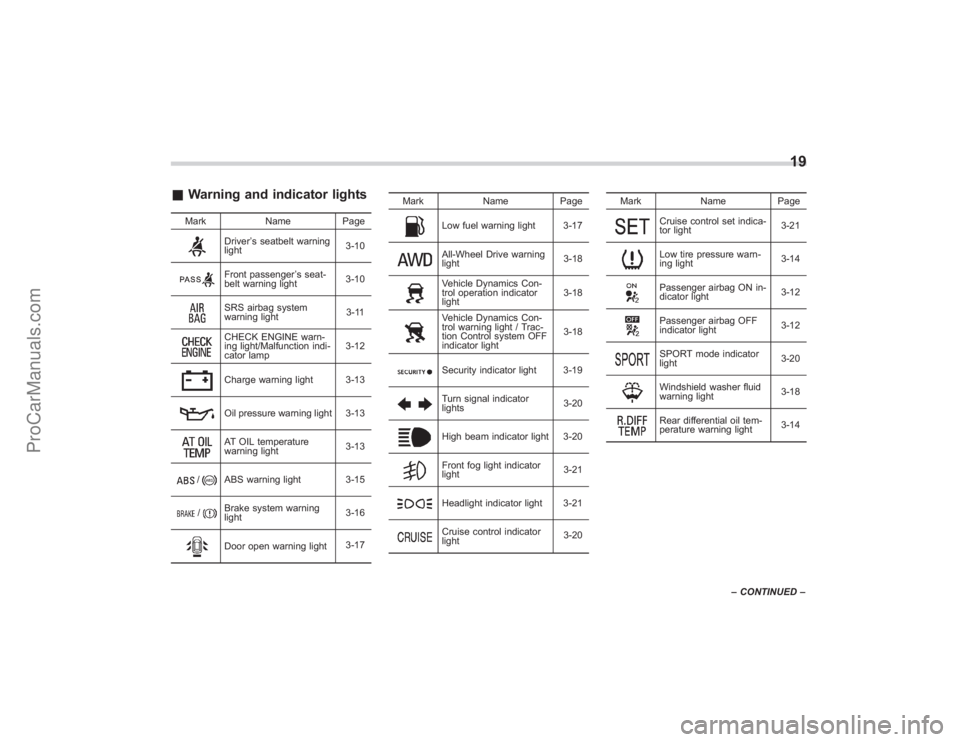
&Warning and indicator lights
Mark NamePage
Driver’s seatbelt warning
light 3-10Front passenger
’s seat-
belt warning light 3-10SRS airbag system
warning light 3-11CHECK ENGINE warn-
ing light/Malfunction indi-
cator lamp3-12Charge warning light 3-13Oil pressure warning light 3-13AT OIL temperature
warning light
3-13
/
ABS warning light 3-15
/
Brake system warning
light3-16Door open warning light
3-17Mark Name Page
Low fuel warning light 3-17All-Wheel Drive warning
light
3-18Vehicle Dynamics Con-
trol operation indicator
light3-18Vehicle Dynamics Con-
trol warning light / Trac-
tion Control system OFF
indicator light3-18Security indicator light 3-19Turn signal indicator
lights
3-20High beam indicator light 3-20Front fog light indicator
light3-21Headlight indicator light 3-21Cruise control indicator
light3-20Mark Name Page
Cruise control set indica-
tor light
3-21Low tire pressure warn-
ing light3-14Passenger airbag ON in-
dicator light
3-12Passenger airbag OFF
indicator light3-12SPORT mode indicator
light
3-20Windshield washer fluid
warning light3-18Rear differential oil tem-
perature warning light3-14
19
–
CONTINUED –
ProCarManuals.com
Page 22 of 409
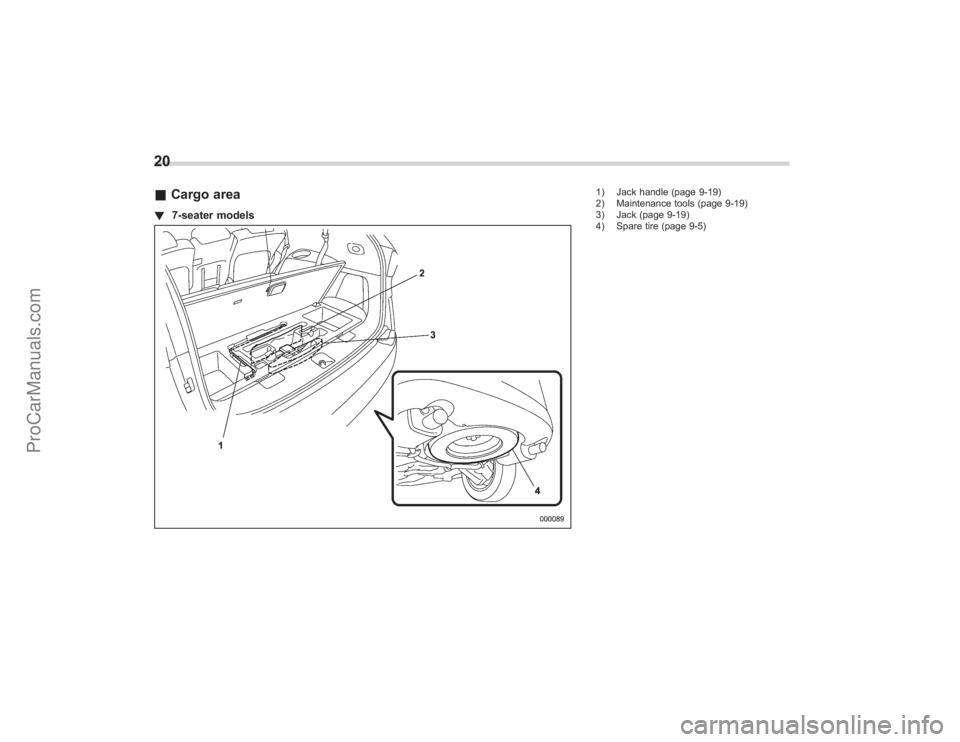
20&Cargo area! 7-seater models
1) Jack handle (page 9-19)
2) Maintenance tools (page 9-19)
3) Jack (page 9-19)
4) Spare tire (page 9-5)
ProCarManuals.com
Page 23 of 409
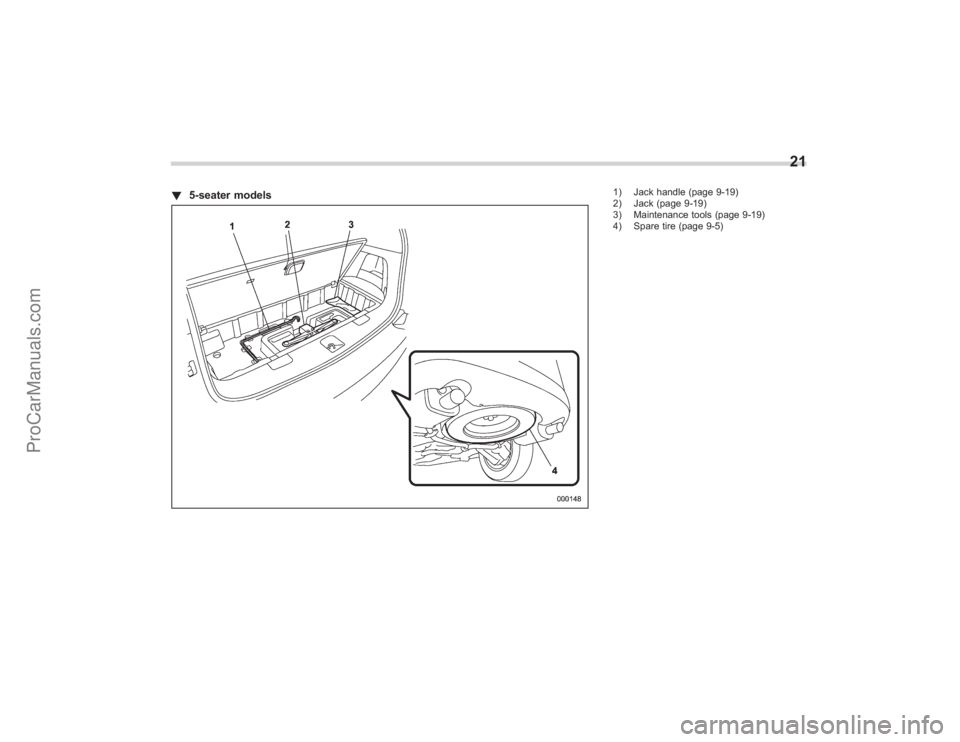
!5-seater models
1) Jack handle (page 9-19)
2) Jack (page 9-19)
3) Maintenance tools (page 9-19)
4) Spare tire (page 9-5)
21
ProCarManuals.com
Page 24 of 409
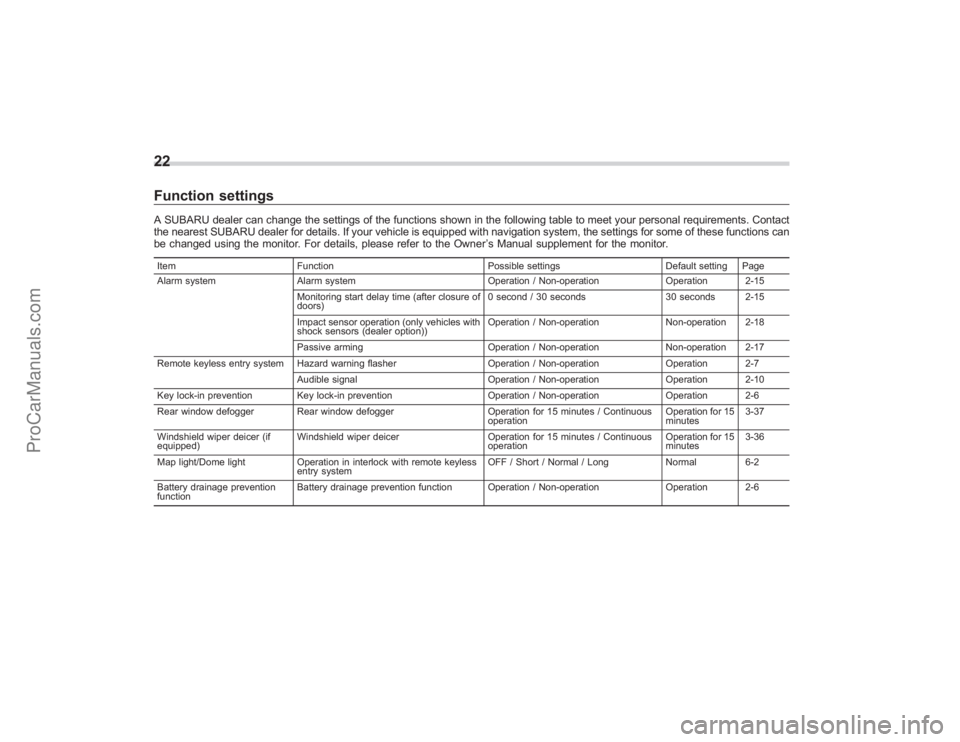
22Function settingsA SUBARU dealer can change the settings of the functions shown in the following table to meet your personal requirements. Contact
the nearest SUBARU dealer for details. If your vehicle is equipped with navigation system, the settings for some of these functions can
be changed using the monitor. For details, please refer to the Owner’s Manual supplement for the monitor.Item Function Possible settingsDefault setting Page
Alarm system Alarm system Operation / Non-operationOperation 2-15
Monitoring start delay time (after closure of
doors) 0 second / 30 seconds
30 seconds 2-15
Impact sensor operation (only vehicles with
shock sensors (dealer option)) Operation / Non-operation
Non-operation 2-18
Passive arming Operation / Non-operationNon-operation 2-17
Remote keyless entry system Hazard warning flasher Operation / Non-operationOperation 2-7
Audible signal Operation / Non-operationOperation 2-10
Key lock-in prevention Key lock-in prevention Operation / Non-operationOperation 2-6
Rear window defogger Rear window defogger Operation for 15 minutes / Continuous
operation Operation for 15
minutes3-37
Windshield wiper deicer (if
equipped) Windshield wiper deicer
Operation for 15 minutes / Continuous
operation Operation for 15
minutes3-36
Map light/Dome light Operation in interlock with remote keyless
entry system OFF / Short / Normal / Long
Normal6-2
Battery drainage prevention
function Battery drainage prevention function Operation / Non-operation
Operation 2-6
ProCarManuals.com
Page 25 of 409
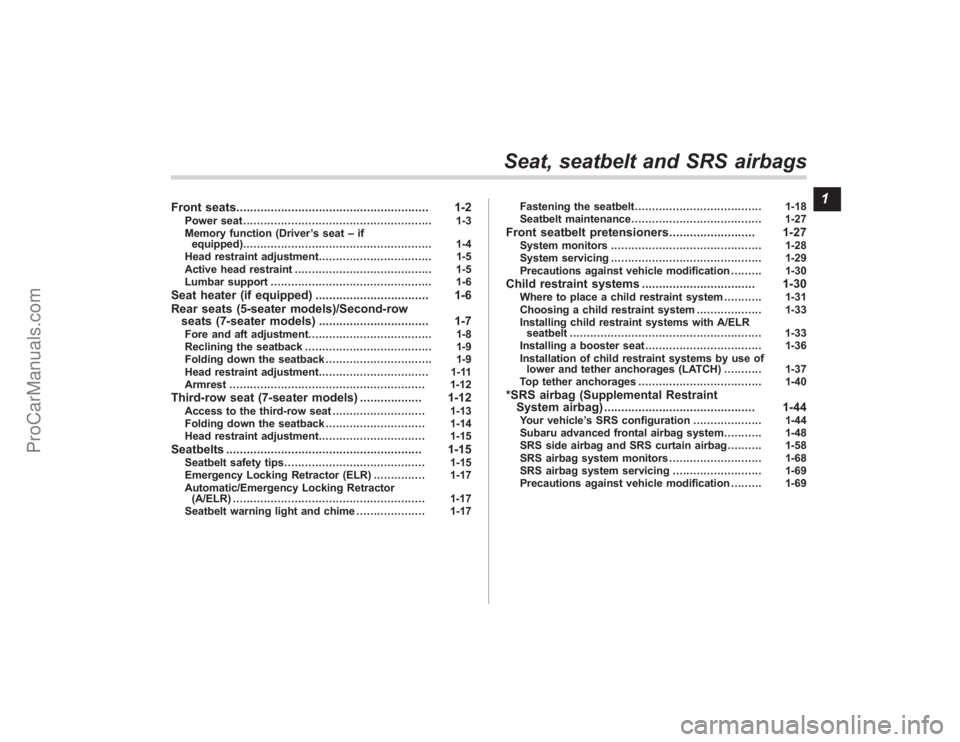
Front seats........................................................ 1-2
Power seat....................................................... 1-3
Memory function (Driver ’s seat –if
equipped) ....................................................... 1-4
Head restraint adjustment ................................. 1-5
Active head restraint ........................................ 1-5
Lumbar support ............................................... 1-6
Seat heater (if equipped) ................................. 1-6
Rear seats (5-seater models)/Second-row seats (7-seater models) ................................ 1-7
Fore and aft adjustment.................................... 1-8
Reclining the seatback ..................................... 1-9
Folding down the seatback ............................... 1-9
Head restraint adjustment ................................ 1-11
Armrest ......................................................... 1-12
Third-row seat (7-seater models) .................. 1-12
Access to the third-row seat........................... 1-13
Folding down the seatback ............................. 1-14
Head restraint adjustment ............................... 1-15
Seatbelts......................................................... 1-15
Seatbelt safety tips ......................................... 1-15
Emergency Locking Retractor (ELR) ............... 1-17
Automatic/Emergency Locking Retractor (A/ELR) ........................................................ 1-17
Seatbelt warning light and chime .................... 1-17Fastening the seatbelt
..................................... 1-18
Seatbelt maintenance...................................... 1-27
Front seatbelt pretensioners ......................... 1-27
System monitors............................................ 1-28
System servicing ............................................ 1-29
Precautions against vehicle modification ......... 1-30
Child restraint systems................................. 1-30
Where to place a child restraint system ........... 1-31
Choosing a child restraint system ................... 1-33
Installing child restraint systems with A/ELR seatbelt ........................................................ 1-33
Installing a booster seat .................................. 1-36
Installation of child restraint systems by use of lower and tether anchorages (LATCH) ........... 1-37
Top tether anchorages .................................... 1-40
*SRS airbag (Supplemental Restraint
System airbag) ............................................ 1-44
Your vehicle’s SRS configuration .................... 1-44
Subaru advanced frontal airbag system ........... 1-48
SRS side airbag and SRS curtain airbag .......... 1-58
SRS airbag system monitors ........................... 1-68
SRS airbag system servicing .......................... 1-69
Precautions against vehicle modification ......... 1-69
Seat, seatbelt and SRS airbags
1
ProCarManuals.com
Page 26 of 409
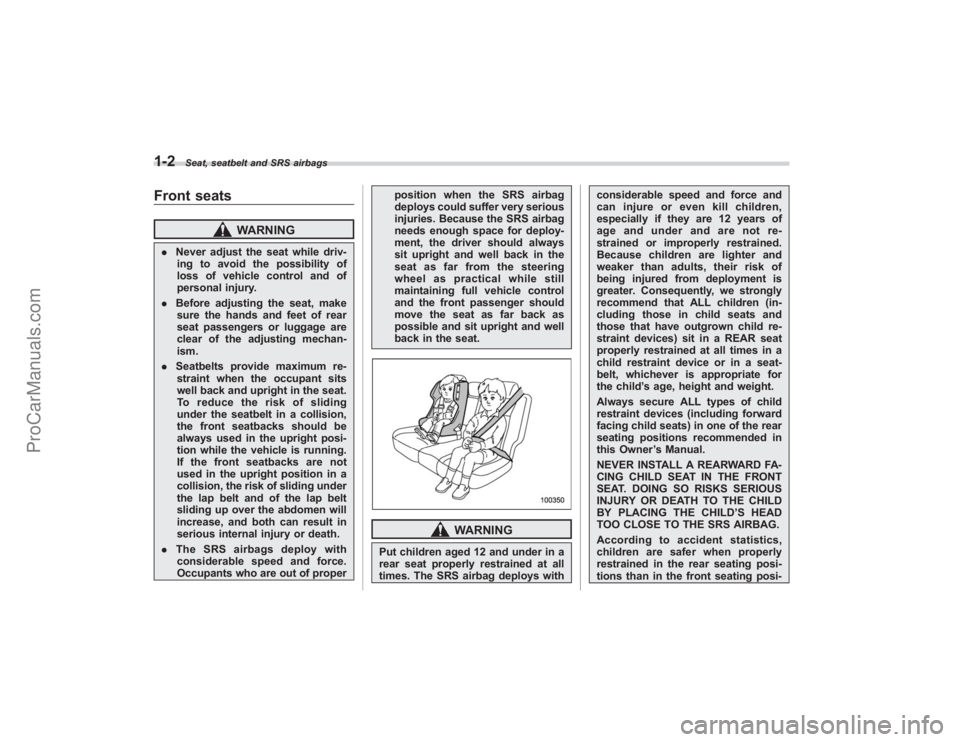
1-2
Seat, seatbelt and SRS airbags
Front seats
WARNING
.Never adjust the seat while driv-
ing to avoid the possibility of
loss of vehicle control and of
personal injury.
. Before adjusting the seat, make
sure the hands and feet of rear
seat passengers or luggage are
clear of the adjusting mechan-
ism.
. Seatbelts provide maximum re-
straint when the occupant sits
well back and upright in the seat.
To reduce the risk of sliding
under the seatbelt in a collision,
the front seatbacks should be
always used in the upright posi-
tion while the vehicle is running.
If the front seatbacks are not
used in the upright position in a
collision, the risk of sliding under
the lap belt and of the lap belt
sliding up over the abdomen will
increase, and both can result in
serious internal injury or death.
. The SRS airbags deploy with
considerable speed and force.
Occupants who are out of proper position when the SRS airbag
deploys could suffer very serious
injuries. Because the SRS airbag
needs enough space for deploy-
ment, the driver should always
sit upright and well back in the
seat as far from the steering
wheel as practical while still
maintaining full vehicle control
and the front passenger should
move the seat as far back as
possible and sit upright and well
back in the seat.
WARNING
Put children aged 12 and under in a
rear seat properly restrained at all
times. The SRS airbag deploys withconsiderable speed and force and
can injure or even kill children,
especially if they are 12 years of
age and under and are not re-
strained or improperly restrained.
Because children are lighter and
weaker than adults, their risk of
being injured from deployment is
greater. Consequently, we strongly
recommend that ALL children (in-
cluding those in child seats and
those that have outgrown child re-
straint devices) sit in a REAR seat
properly restrained at all times in a
child restraint device or in a seat-
belt, whichever is appropriate for
the child
’s age, height and weight.
Always secure ALL types of child
restraint devices (including forward
facing child seats) in one of the rear
seating positions recommended in
this Owner ’s Manual.
NEVER INSTALL A REARWARD FA-
CING CHILD SEAT IN THE FRONT
SEAT. DOING SO RISKS SERIOUS
INJURY OR DEATH TO THE CHILD
BY PLACING THE CHILD ’S HEAD
TOO CLOSE TO THE SRS AIRBAG.
According to accident statistics,
children are safer when properly
restrained in the rear seating posi-
tions than in the front seating posi-
ProCarManuals.com
Page 27 of 409
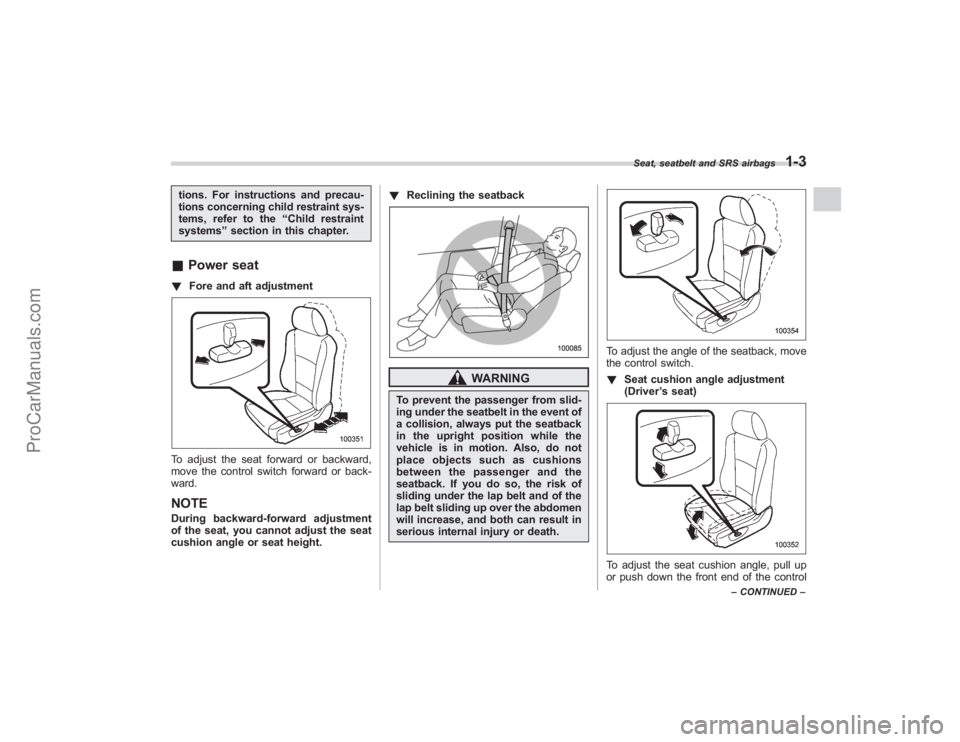
tions. For instructions and precau-
tions concerning child restraint sys-
tems, refer to the“Child restraint
systems ”section in this chapter.& Power seat! Fore and aft adjustmentTo adjust the seat forward or backward,
move the control switch forward or back-
ward.NOTEDuring backward-forward adjustment
of the seat, you cannot adjust the seat
cushion angle or seat height. !
Reclining the seatback
WARNING
To prevent the passenger from slid-
ing under the seatbelt in the event of
a collision, always put the seatback
in the upright position while the
vehicle is in motion. Also, do not
place objects such as cushions
between the passenger and the
seatback. If you do so, the risk of
sliding under the lap belt and of the
lap belt sliding up over the abdomen
will increase, and both can result in
serious internal injury or death.
To adjust the angle of the seatback, move
the control switch.
! Seat cushion angle adjustment
(Driver ’s seat)To adjust the seat cushion angle, pull up
or push down the front end of the control
Seat, seatbelt and SRS airbags
1-3
– CONTINUED –
ProCarManuals.com
Page 28 of 409
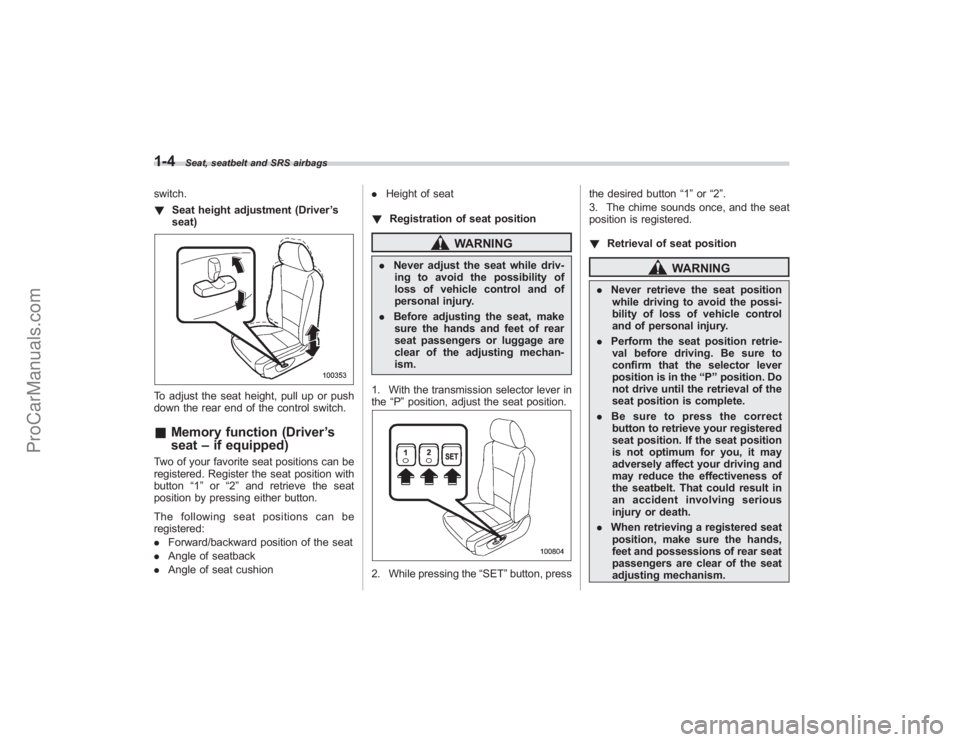
1-4
Seat, seatbelt and SRS airbags
switch.
!Seat height adjustment (Driver ’s
seat)To adjust the seat height, pull up or push
down the rear end of the control switch.& Memory function (Driver ’s
seat –if equipped)Two of your favorite seat positions can be
registered. Register the seat position with
button “1” or “2” and retrieve the seat
position by pressing either button.
The following seat positions can be
registered:
. Forward/backward position of the seat
. Angle of seatback
. Angle of seat cushion .
Height of seat
! Registration of seat position
WARNING
.Never adjust the seat while driv-
ing to avoid the possibility of
loss of vehicle control and of
personal injury.
. Before adjusting the seat, make
sure the hands and feet of rear
seat passengers or luggage are
clear of the adjusting mechan-
ism.
1. With the transmission selector lever in
the “P”position, adjust the seat position.2. While pressing the “SET”button, press the desired button
“1”or “2”.
3. The chime sounds once, and the seat
position is registered.
! Retrieval of seat position
WARNING
.Never retrieve the seat position
while driving to avoid the possi-
bility of loss of vehicle control
and of personal injury.
. Perform the seat position retrie-
val before driving. Be sure to
confirm that the selector lever
position is in the “P ” position. Do
not drive until the retrieval of the
seat position is complete.
. Be sure to press the correct
button to retrieve your registered
seat position. If the seat position
is not optimum for you, it may
adversely affect your driving and
may reduce the effectiveness of
the seatbelt. That could result in
an accident involving serious
injury or death.
. When retrieving a registered seat
position, make sure the hands,
feet and possessions of rear seat
passengers are clear of the seat
adjusting mechanism.
ProCarManuals.com
Page 29 of 409
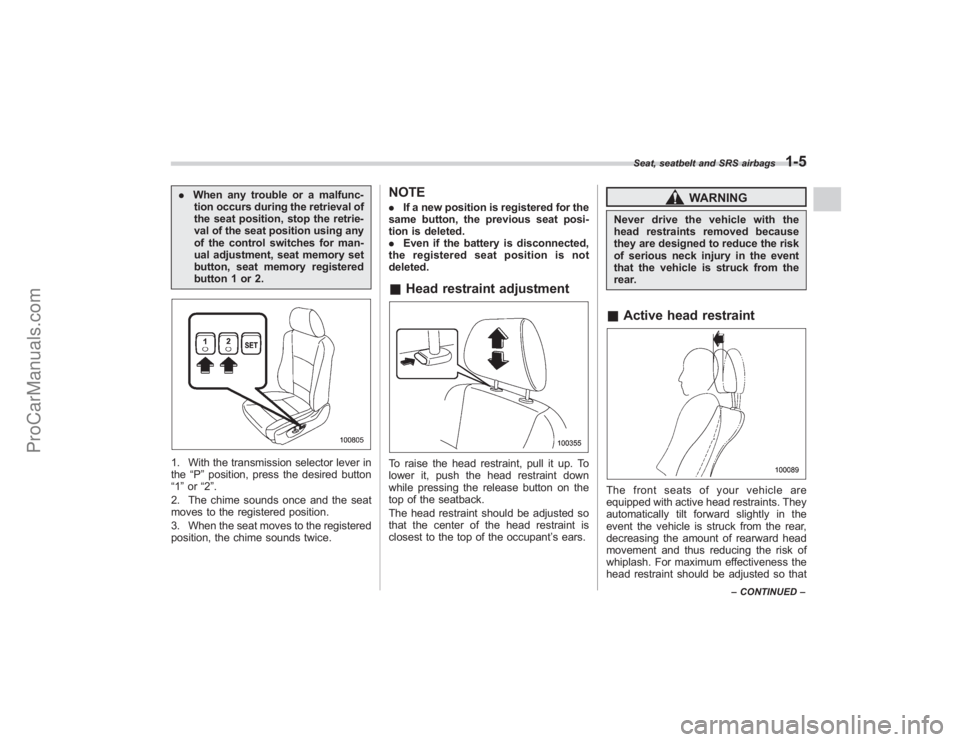
.When any trouble or a malfunc-
tion occurs during the retrieval of
the seat position, stop the retrie-
val of the seat position using any
of the control switches for man-
ual adjustment, seat memory set
button, seat memory registered
button 1 or 2.1. With the transmission selector lever in
the “P”position, press the desired button
“1 ”or “2”.
2. The chime sounds once and the seat
moves to the registered position.
3. When the seat moves to the registered
position, the chime sounds twice.
NOTE. If a new position is registered for the
same button, the previous seat posi-
tion is deleted.
. Even if the battery is disconnected,
the registered seat position is not
deleted.& Head restraint adjustmentTo raise the head restraint, pull it up. To
lower it, push the head restraint down
while pressing the release button on the
top of the seatback.
The head restraint should be adjusted so
that the center of the head restraint is
closest to the top of the occupant ’s ears.
WARNING
Never drive the vehicle with the
head restraints removed because
they are designed to reduce the risk
of serious neck injury in the event
that the vehicle is struck from the
rear.& Active head restraintThe front seats of your vehicle are
equipped with active head restraints. They
automatically tilt forward slightly in the
event the vehicle is struck from the rear,
decreasing the amount of rearward head
movement and thus reducing the risk of
whiplash. For maximum effectiveness the
head restraint should be adjusted so that
Seat, seatbelt and SRS airbags
1-5
–CONTINUED –
ProCarManuals.com
Page 30 of 409
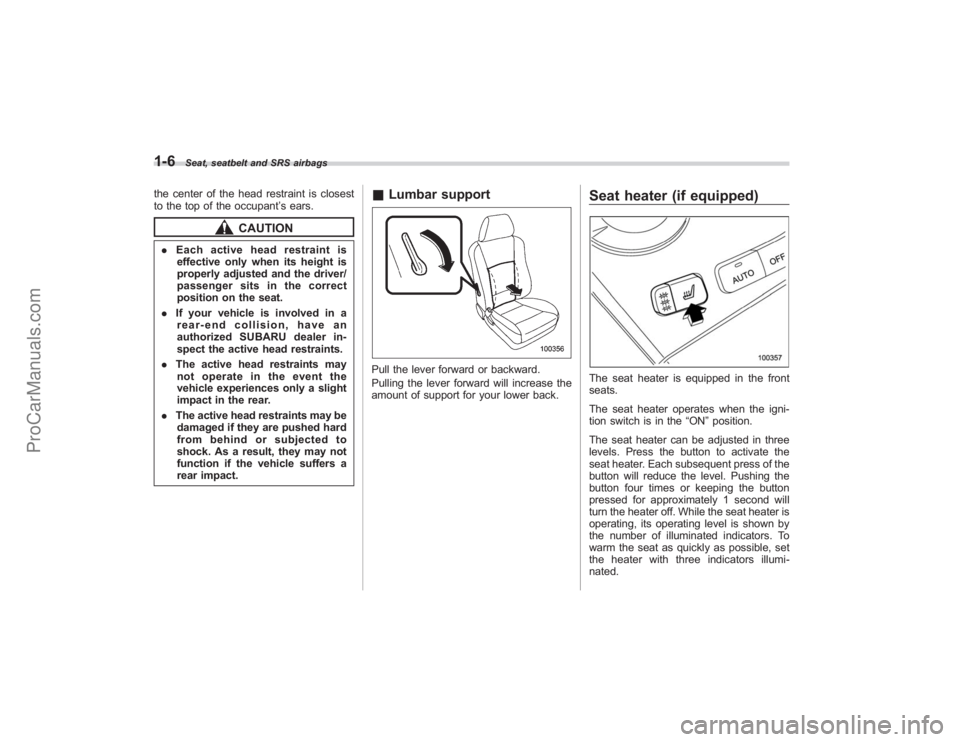
1-6
Seat, seatbelt and SRS airbags
the center of the head restraint is closest
to the top of the occupant’s ears.
CAUTION
. Each active head restraint is
effective only when its height is
properly adjusted and the driver/
passenger sits in the correct
position on the seat.
. If your vehicle is involved in a
rear-end collision, have an
authorized SUBARU dealer in-
spect the active head restraints.
. The active head restraints may
not operate in the event the
vehicle experiences only a slight
impact in the rear.
. The active head restraints may be
damaged if they are pushed hard
from behind or subjected to
shock. As a result, they may not
function if the vehicle suffers a
rear impact.
& Lumbar supportPull the lever forward or backward.
Pulling the lever forward will increase the
amount of support for your lower back.
Seat heater (if equipped)The seat heater is equipped in the front
seats.
The seat heater operates when the igni-
tion switch is in the “ON”position.
The seat heater can be adjusted in three
levels. Press the button to activate the
seat heater. Each subsequent press of the
button will reduce the level. Pushing the
button four times or keeping the button
pressed for approximately 1 second will
turn the heater off. While the seat heater is
operating, its operating level is shown by
the number of illuminated indicators. To
warm the seat as quickly as possible, set
the heater with three indicators illumi-
nated.
ProCarManuals.com